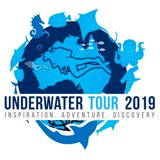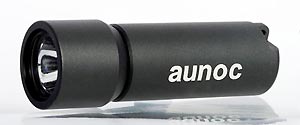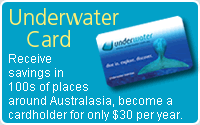
New user? Login here or
Articles
 Diving Wolf Rocks and Julian Rocks
Diving Wolf Rocks and Julian Rocks- by Fergy added 2005-07-11
- Jude and I left Townsville on three weeks holidays heading South of Brisbane to Murwillumbah in northern NSW, whilst down there I managed to do 3 dives.
 Destination Cocos (Keeling) Islands
Destination Cocos (Keeling) Islands- by Wandy Hochgrebe added 2005-06-29
- If you are looking for a tropical holiday destination with amazing diving the Cocos (Keeling) Islands and Christmas Island should be on your list. The islands are part of Australia, but are actually located closer to Indonesia.
 Fancy a squid kiss?
Fancy a squid kiss?- by Ric Mingramm added 2005-06-27
- Once again I was privileged enough to dive with my A team (or should it be eh? team)(Ansdrew Bennett, Amber Nelson, Troy Stefan) on a recent trip to Coffs Harbour.
 Coffs Harbour - Time to do it again!
Coffs Harbour - Time to do it again!- by Ric Mingramm added 2005-06-27
- Well, I take my annual pilgrimage to what is some of the best diving in Australia (not because of the diving JUST but because of the fantastic dive operator).
 Bula Baby!
Bula Baby!- by Jo added 2005-06-11
- It all started on flying in early on Friday the 22nd (a day before the rest of the crew, which were coming from the US). I received the most wonderful welcome and had a great time scoping out my new home for the next week and a half before having a great nights rest in my DOUBLE KING sized bed, meaning that it was about 4m wide (never knew they made beds that large!). I awoke to the sound of "Yeeeehaw" echoing through the place and knew at once that the Texans and the rest of the gang had arrived.
 Padbury Senior Highschool dive with sharks
Padbury Senior Highschool dive with sharks- by mlehmann added 2005-06-07
- "Hey Boss, I really want to take 12 kids diving with about 16 sharks" is not a good request in the days following a tragic attack at the Abrolhos (and the request to take a group there later in the year is a completely different issue!!), and the request being granted was an even larger surprise.
 Diving Artificial Reefs
Diving Artificial Reefs- by PJ added 2005-06-07
- When you dive on a shipwreck, jetty or pier do you consider it a nature-based experience? This is one of the major questions I am seeking to address in my PhD thesis at the University of Newcastle, which looks at the use of artificial reefs as resources for recreational scuba diving.
 Contribution to History of Recreational Diving in Victoria, Australia.
Contribution to History of Recreational Diving in Victoria, Australia.- by ray added 2005-05-01
- From looking at sites offering some points of history in regard to diving in Australia, I found nothing in relation to what was once the highest volume retailer of SCUBA equipment and dive accessories in the Southern Hemisphere, circa 1960's.
 Tagging Whale Sharks - be part of it
Tagging Whale Sharks - be part of it- by Bronya added 2005-04-19
- I want to tell you about a new non-invasive method of tagging whale sharks that everyone who has an underwater camera, digital or film it doesn't matter, can get involved in.
 Revealing the secrets of the Bullshark in the South-Pacific
Revealing the secrets of the Bullshark in the South-Pacific- by Juerg Brunnschweiler added 2005-04-18
- Populations of large marine predators such as sharks are in dangerous decline. Recent scientific studies report declines of up to 99% for several shark species such as the oceanic whitetip shark in the Gulf of Mexico. Studies also indicate that the reduction in number of larger coastal species such as bull, hammerhead, and tiger sharks may be as high as 80% in the Atlantic Ocean.
 Pineconefishes
Pineconefishes- by Steve Griffin added 2005-04-14
- These non-aggressive fish are named for there pinecone or pineapple like appearance.
 Peer Pressure - an article for the novice diver
Peer Pressure - an article for the novice diver- by Hilary added 2005-04-14
- We had recently completed our Open Water Dive Course. My partner and I couldn't wait for our planned 6 day dive-holiday, on the beautiful Ningaloo Reef in Western Australia.
 Narcosis is very real!
Narcosis is very real!- by Tod added 2005-04-04
- This event took place a number of years ago while diving with a few mates on a charter in Tassie. We had planned to dive the famous kelp forests in EagleHawk Bay, Tasmania and a wall dive recommended by the skipper/guide.
 Dive, eat, sleep - Liveaboard Survey
Dive, eat, sleep - Liveaboard Survey- by Scuba Diver Australasia added 2005-04-03
- A live aboard dive holiday is the ultimate choice for the dedicated diver and underwater photographers. However there are some important issues to consider prior to making a reservation.
 Working with HMI lights
Working with HMI lights- by Scuba Diver Australasia added 2005-04-03
- HMI technology is not new. It evolved in the late 1960s when lamp developer Osram began producing HMI bulbs for the film industry at the request of German television seeking a less expensive alternative to incandescent lights. Ironically, HMI is now much more expensive than halogen and tungsten.









